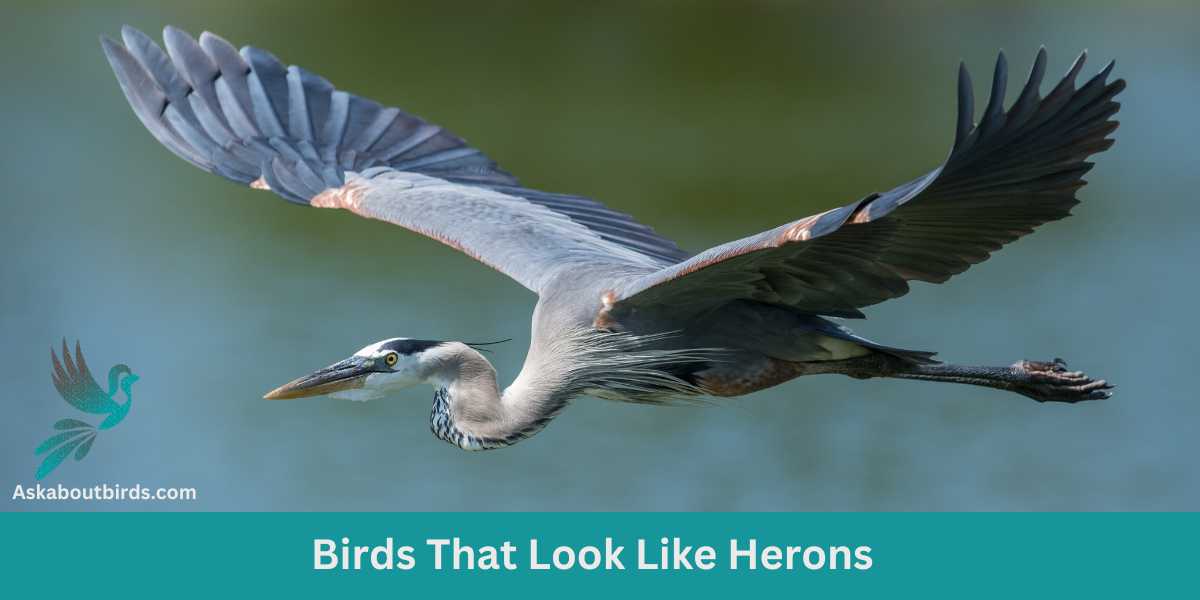Herons, with their majestic stature, elegant plumage, and characteristic long necks and legs, are captivating birds. Yet, they’re not the only ones to embody these traits. Several other birds mirror the heron’s grace and elegance, creating a delightful array of biodiversity.
We delve into the fascinating world of birds that look like similar to Great Blue Herons– some closely related, others merely bearing a striking resemblance.
Great Blue Heron
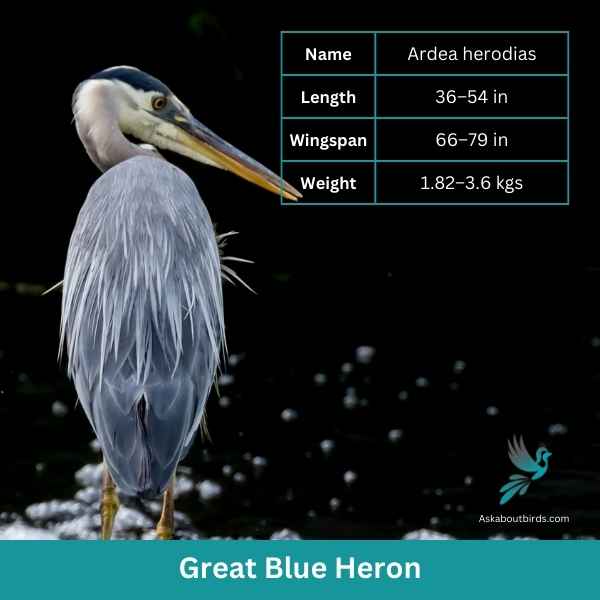
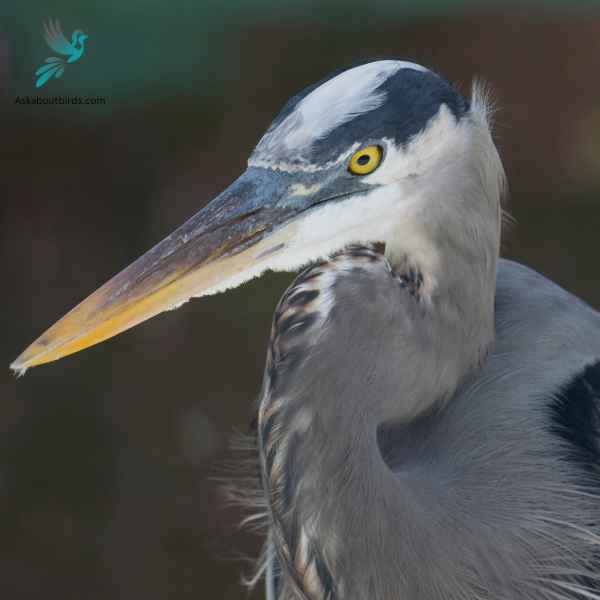
| Feature | Measurement |
|---|---|
| Scientific Name | Ardea herodias |
| Length | 36–54 in |
| Wingspan | 66–79 in |
| Weight | 1.82–3.6 kgs |
Great Blue Herons are the largest heron species in North America, is distinguished by its tall stature and unique blue-gray plumage.
Measuring up to 4.5 feet tall with a wingspan of approximately 6.5 feet, the bird features a long, pointed bill, a white head with a black eye stripe extending to slender black plumes, and robust, elongated legs. Its distinctive flight pattern, forming a tight “S” shape with its neck, sets it apart from similar large birds, like cranes.
Inhabiting various wetland habitats, including marshes, lakes, rivers, and coastal regions throughout much of North and Central America, the Great Blue Heron is a wading bird. Often seen poised statue-like at the water’s edge, these birds are expert hunters, spearing fish and capturing small animals with their sharp bills.
Birds That Look Like Herons
Herons are recognized by certain distinct features: a long, sharp beak; tall, slender legs; and a neck that coils into an “S” shape. These traits, apart from being distinctive, are essential for their survival, particularly for hunting in shallow waters.
Birds resembling herons often share these physical characteristics, and in some cases, similar behaviors too. Some of these birds may be closely related to herons, belonging to the same family, Ardeidae, while others may belong to different families but have evolved similar traits due to similar environmental needs, a fascinating example of convergent evolution.
Close Relatives: Egrets and Bitterns
Great Egret
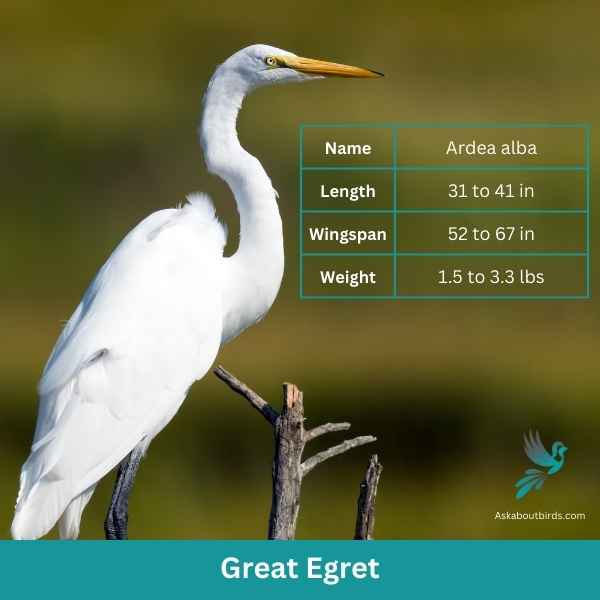
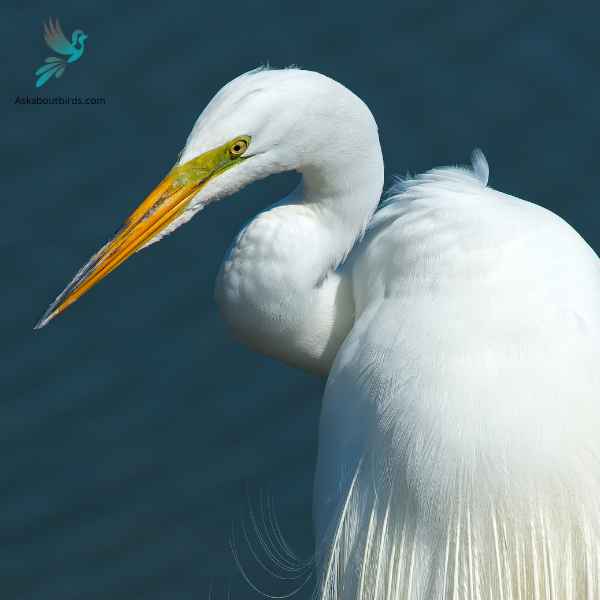
| Feature | Measurement |
|---|---|
| Scientific Name | Ardea alba |
| Length | 31 to 41 in |
| Wingspan | 52 to 67 in |
| Weight | 1.5 to 3.3 lbs |
The Great Egret (Ardea alba), also known as the Common Egret, is a large, elegant wading bird recognized for its brilliant white plumage, slender black legs, and long, dagger-like yellow bill.
With a height of up to 3.3 feet and a wingspan of 52 to 67 inches, this bird is amongst the largest of the heron species. Its stately appearance and serene comportment have made it a popular symbol in many cultures and an eye-catching sight in its habitats.
Found across all continents except Antarctica, the Great Egret resides in both fresh and saltwater wetlands, including marshes, ponds, and coastal areas. It feeds mainly on fish, but it also hunts amphibians, small mammals, and invertebrates.
Similarities
- Like herons, Great Egrets are wading birds with long necks and legs.
- They have a similar diet, feeding on fish and invertebrates.
Differences
- Great Egrets are larger than many herons.
- They have all-white plumage, unlike many herons which have more varied colors.
Snowy Egret

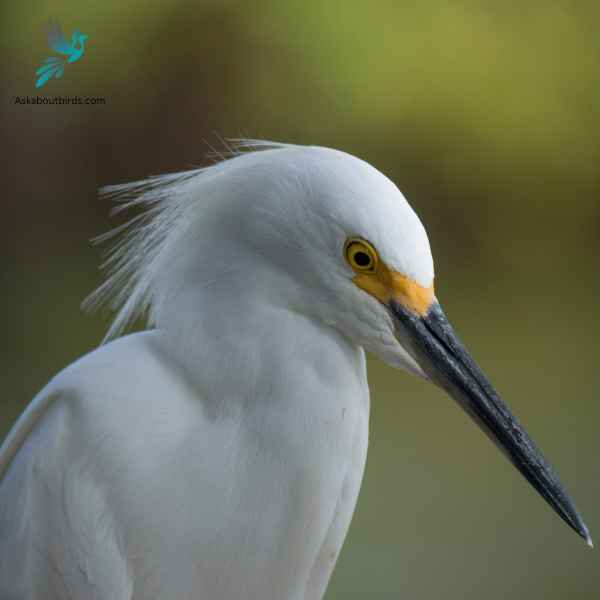
| Feature | Measurement |
|---|---|
| Scientific Name | Egretta thula |
| Length | 22.1–26.0 in |
| Wingspan | 39.4 in |
| Weight | 370 g |
The Snowy Egret (Egretta thula) is a small and active wading bird, celebrated for its delicate beauty. It sports an entirely white plumage that appears to glow against its black bill and legs, and striking yellow feet, which often play a crucial role in luring prey during feeding.
The Snowy Egret is further adorned with fine, plume-like feathers on its head, neck, and back during the breeding season, making it one of the more distinctive heron species.
Inhabiting wetland areas across the Americas, the Snowy Egret can be found in marshes, swamps, shorelines, and tidal flats where it feeds primarily on fish, but also consumes insects, crustaceans, and small reptiles.
Similarities
- Snowy Egrets, like herons, have long legs and necks used for wading and hunting.
- Both have similar diets consisting of fish, insects, and other small animals.
Differences
- Snowy Egrets are smaller than most herons.
- They have distinctive yellow feet, which most herons lack.
Cattle Egret

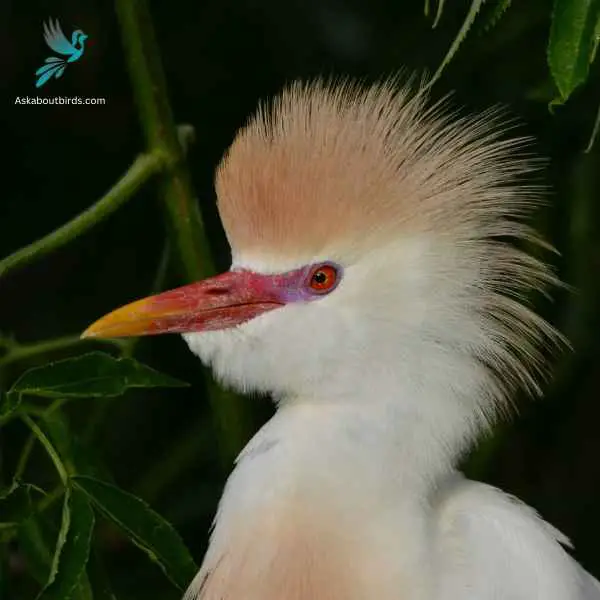
| Feature | Measurement |
|---|---|
| Scientific Name | Bubulcus ibis |
| Length | 18–22 in |
| Wingspan | 34+1⁄2–38 in |
| Weight | 270–512 g |
The Cattle Egret is a small heron species found globally. Its widespread presence results from its remarkable adaptability to diverse environments, often seen among grazing livestock or agricultural fields.
Appearance: Cattle Egrets are usually white with a slightly hunched posture and a relatively short neck compared to other heron species. Their bills and legs are yellow but can turn red or orange during the breeding season. During this period, they also grow buff-colored patches on their head, chest, and back.
Diet: The diet of the Cattle Egret mainly consists of insects and other small creatures, which they often catch in fields and meadows. They are particularly known for following cattle or other large mammals, catching insects disturbed by these animals’ movements.
Similarities
- Cattle Egrets and herons both have long legs and necks.
- Both species are often found near bodies of water.
Differences
- Cattle Egrets are typically found in drier habitats and often around livestock, unlike most herons.
- They have shorter, thicker necks compared to most herons.
Little Egret

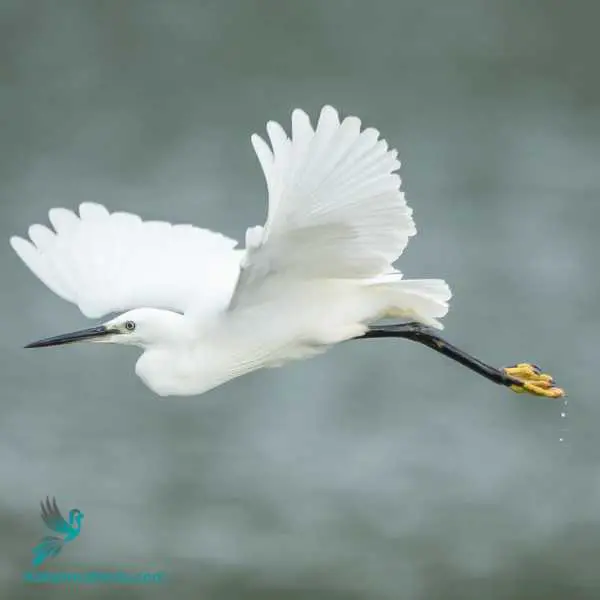
| Feature | Measurement |
|---|---|
| Scientific Name | Egretta garzetta |
| Length | 22–26 in |
| Wingspan | 35–42 in |
| Weight | 0.77–1.21 lb |
The Little Egret is an elegant, white water bird that can often be seen hunting in both marine and freshwater habitats across many parts of the world.
Appearance: Dressed in pure white plumage, the Little Egret is a picture of grace. Both sexes are alike, featuring long, black legs tipped with bright yellow feet, and a sharp, black bill. During the breeding season, adult birds develop beautiful, ornate plumes on their back and chest, creating a spectacle of their usually sleek figure.
Diet: The Little Egret’s diet is mainly composed of fish, but they will also eat amphibians, small invertebrates, insects, and occasionally small mammals. Their hunting method is active; they stir the water with their feet to flush out prey, then quickly strike with their bill.
Reproduction: The Little Egret’s nests are platform-like structures made of sticks, usually built in trees or shrubs near water bodies. They often nest in colonies, sometimes mixed with other heron or egret species. The female lays a clutch of about 3 to 5 pale blue-green eggs, and both parents take turns incubating them.
Similarities
- Like herons, Little Egrets are wading birds with long necks and legs.
- Both species have similar diets.
Differences
- Little Egrets are smaller than most herons.
- They have black legs and yellow feet, which most herons lack.
Reddish Egret
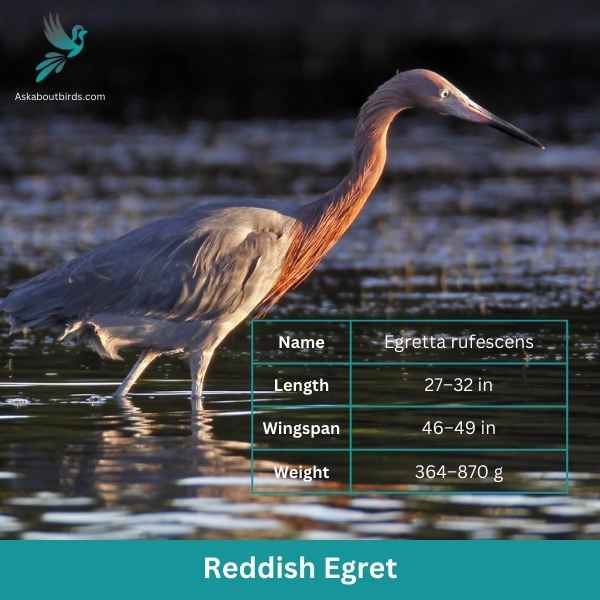
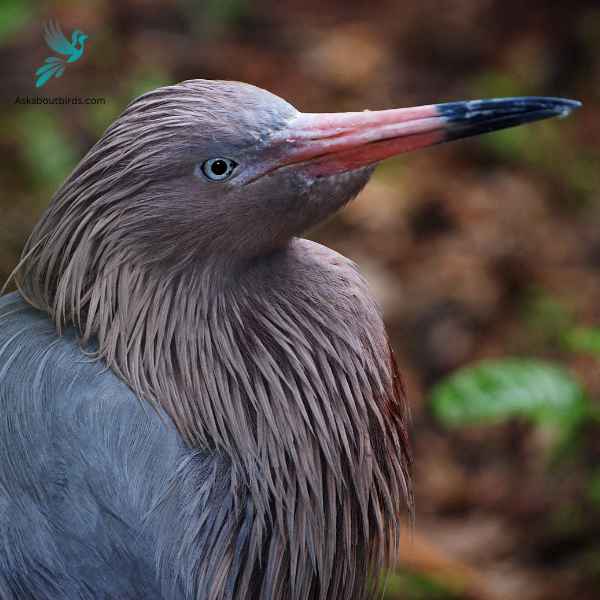
| Feature | Measurement |
|---|---|
| Scientific Name | Egretta rufescens |
| Length | 27–32 in |
| Wingspan | 46–49 in |
| Weight | 364–870 g |
The Reddish Egret (Egretta rufescens) is a medium-sized heron species recognized for its unusual coloration and lively hunting behavior.
It comes in two distinct color morphs: a dark form that displays a bluish body with a reddish neck and head, and a white form that is entirely white. Its bill is pink at the base, transitioning to black towards the tip, and its legs and feet are bluish-gray.
The Reddish Egret’s habitat stretches along the coastal regions of the southern United States, Mexico, Central America, and the Caribbean, where it frequents saltwater marshes, lagoons, and shallow bays. It is known for its “dance” when hunting, running in shallow water with wings spread and dipping its head to catch fish.
Similarities
- Reddish Egrets, like herons, are wading birds and have a similar diet of fish and invertebrates.
- Both have long legs and necks.
Differences
- Reddish Egrets have a distinctive reddish color, unlike most herons.
- They have a unique hunting style, often running, jumping, and spinning in the pursuit of prey.
American Bittern

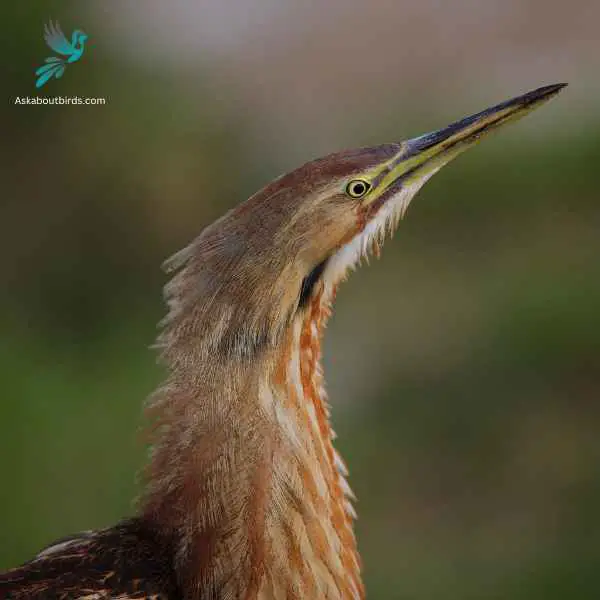
| Feature | Measurement |
|---|---|
| Scientific Name | Botaurus lentiginosus |
| Length | 23–33 in |
| Wingspan | 36–45 in |
| Weight | 370–1,072 g |
The American Bittern (Botaurus lentiginosus) is a wading bird of the heron family, widely recognized for its exceptional camouflage. The bird’s streaky, brown plumage perfectly imitates the reeds and tall grasses of its wetland habitats, rendering it nearly invisible when it stands still with its bill pointing upwards. It is medium-sized with a stocky body, a long neck, and a thick, pointed bill, characteristics that enable its hunting lifestyle.
In terms of behavior, the American Bittern is extremely secretive and solitary, spending most of its time hidden in marshes and wetlands across North America. The species is most known for its distinctive call, which resembles the sound of a water pump, earning it the colloquial name, ‘stake-driver’ or ‘thunder-pumper’. It is primarily a carnivore, hunting for fish, amphibians, and insects in its watery habitat.
Similarities
- Like herons, American Bitterns are wading birds and have similar diets.
- Both have long necks and beaks.
Differences
- American Bitterns have a shorter neck and more cryptic, streaked plumage compared to most herons.
- They tend to be more secretive and less likely to be seen in the open than herons.
Least Bittern
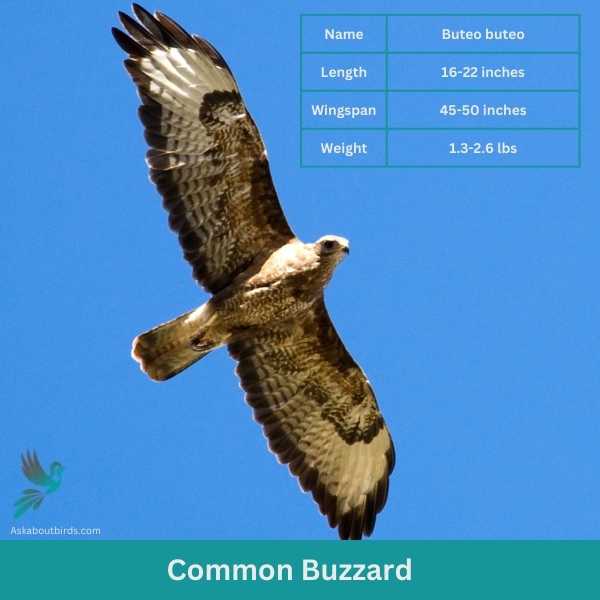

| Feature | Measurement |
|---|---|
| Scientific Name | Ixobrychus exilis |
| Length | 11–14 in |
| Wingspan | 16–18 in |
| Weight | 2.1–5.3 oz |
The Least Bittern is a secretive bird, spending most of its time among dense reeds and marsh vegetation in North and Central America.
Appearance: Despite its small size, the Least Bittern exhibits striking sexual dimorphism. Males sport rich black-brown upperparts and a pale, buff-colored underside streaked with brown. Females and juveniles, on the other hand, have more uniformly brown plumage. Both sexes feature yellow eyes, a sharp bill, and relatively long legs, allowing them to wade through their preferred marshy habitats.
Diet: The Least Bittern feeds mainly on fish and aquatic invertebrates, including insects, crayfish, and small frogs. It is an excellent hunter, using its long, sharp bill to spear or snatch its prey as it wades stealthily through the reeds.
Reproduction: Unlike many water birds, Least Bitterns build their nests in the dense vegetation of freshwater marshes, often suspended above the water. The female lays a clutch of usually 4-5 eggs, which are then incubated by both parents.
Similarities
- Least Bitterns, like herons, are wading birds and have similar diets.
- Both have long necks and beaks.
Differences
- Least Bitterns are smaller than most herons.
- They have a more reclusive lifestyle compared to herons.
The Night-Herons:
Black-Crowned Night-Heron


| Feature | Measurement |
|---|---|
| Scientific Name | Nycticorax nycticorax |
| Length | 22.8-26.0 in |
| Wingspan | 45.3-46.5 in |
| Weight | 727-1014 g |
The Black-Crowned Night-Heron (Nycticorax nycticorax) is a medium-sized heron species known for its distinct nocturnal habits and characteristic appearance. The bird displays a stocky silhouette, with a black crown and back, contrasting starkly with its light grey wings and white underparts.
Its eyes are large and red, adapted for its night-time activities, and its legs are relatively short for a heron. The bill is sturdy and black, and during the breeding season, two to three long white plumes extend from the back of the head.
Residing in a wide variety of wetland habitats, from freshwater marshes to coastal regions, the Black-Crowned Night-Heron is found across a large global range, including the Americas, Europe, Asia, and Africa. The species primarily feeds on fish and invertebrates, but it is known to be opportunistic and will also eat small mammals, birds, and eggs.
Similarities
- Like herons, Black-Crowned Night-Herons are wading birds and have similar diets.
- Both have long necks and legs.
Differences
- Black-Crowned Night-Herons have a shorter, stockier build compared to most herons.
- They are nocturnal, unlike most herons.
Yellow-Crowned Night-Heron

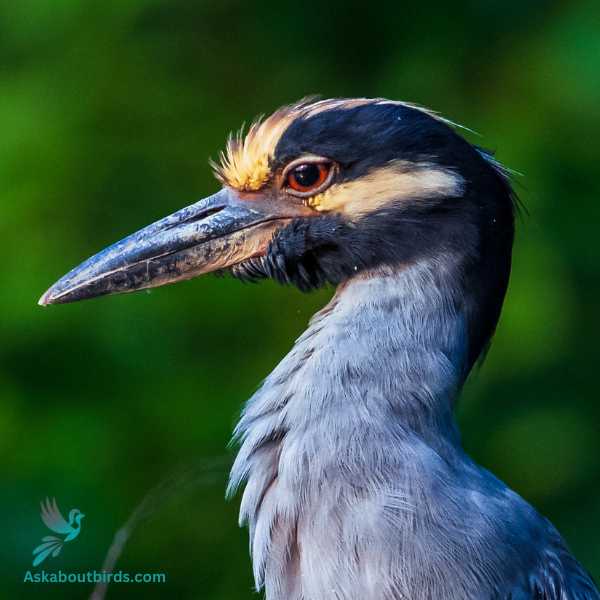
| Feature | Measurement |
|---|---|
| Scientific Name | Nyctanassa violacea |
| Length | 22–24 in |
| Wingspan | 40–45 in |
| Weight | 1.38–1.87 lbs |
The Yellow-Crowned Night-Heron is a medium-sized heron found in the Americas, recognized for its nocturnal habits and striking plumage.
Appearance: The Yellow-Crowned Night-Heron features a sturdy body with a thick neck, short legs, and a black bill. It exhibits a pale gray body, a black head, and an attractive yellow crown, from which it derives its name. Its eyes are a captivating red, contrasting strikingly with the yellow on the head. Younger birds have a softer, browner coloration that gradually transitions to the adult’s striking palette.
Diet: The Yellow-Crowned Night-Heron feeds primarily on crustaceans, such as crabs and crayfish, making its home in mangroves, saltwater marshes, and other wetland habitats rich in these food sources. It also eats insects, fish, and occasionally plant matter.
Reproduction: The Yellow-Crowned Night-Heron nests in colonies, often with other bird species. They build a rather simplistic nest out of sticks. The female typically lays 2-6 eggs.
Similarities
- Like herons, Yellow-Crowned Night-Herons are wading birds and have similar diets.
- Both have long necks and legs.
Differences
- Yellow-Crowned Night-Herons have a shorter, stockier build compared to most herons.
- They have a distinctive yellow crown, unlike most herons.
Birds That Mirror Heron Silhouettes:
Sandhill Crane

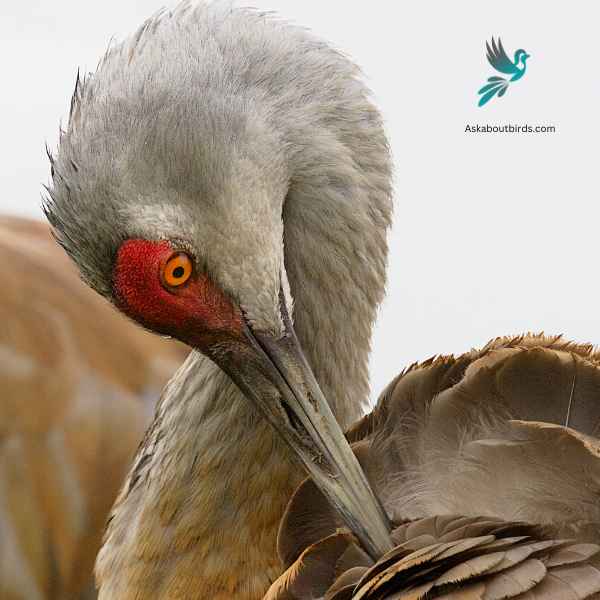
| Feature | Measurement |
|---|---|
| Scientific Name | Antigone canadensis |
| Length | 2 ft 7 in to 4 ft 6 in |
| Wingspan | 16.5–23.6 in |
| Weight | 4.02-4.57 kg |
The Sandhill Crane (Antigone canadensis) is a distinguished bird species found in the family Gruidae, renowned for its majestic presence and elaborate courtship dances.
These long-legged birds stand approximately 4 feet tall with a wingspan of up to 7 feet, marked by gray bodies, white cheeks, pointy dark bills, and an iconic red cap on their heads. Typically, they inhabit grasslands, marshes, and fields across North America, Siberia, and Cuba.
Being omnivorous, Sandhill Cranes thrive on a varied diet consisting of plant material, small mammals, amphibians, and insects. With a lifespan reaching up to 20 years in the wild, they remain one of the most widespread crane species globally.
Similarities
- Like herons, Sandhill Cranes are tall birds that often inhabit wetlands.
- Both have long necks and legs.
Differences
- Sandhill Cranes are larger and have a more robust body compared to most herons.
- They have a bald red forehead, unlike most herons.
White Stork
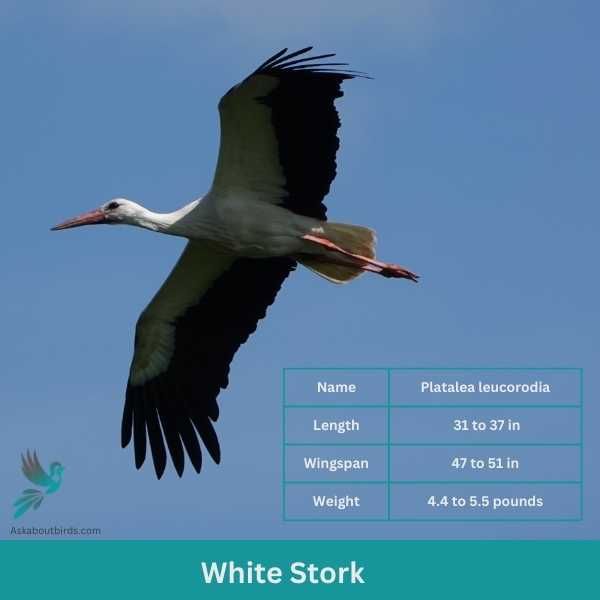

| Feature | Measurement |
|---|---|
| Scientific Name | Ciconia ciconia |
| Length | 39–45 in |
| Wingspan | 61–85 in |
| Weight | 5.1–9.7 lb |
The White Stork is a large, elegant bird notable for its contrasting black and white plumage. These storks forage in grasslands and shallow wetlands, hunting for a range of food items, including insects, fish, amphibians, reptiles, small mammals, and birds.
The White Stork is a tall, long-legged wading bird. Its distinctive bill is long, straight, and pointed, perfectly adapted for hunting. Adults are primarily white with black flight feathers, while the legs and the long bill are bright red. Immature storks resemble adults but have duller plumage and a darker bill.
The vocal sounds of the White Stork are not as prominent, as they are mostly silent. However, they are known for their unique way of communication through “bill-clattering”, a rapid opening and closing of their beak producing a rattle-like sound.
Similarities
- White Storks, like herons, have long legs and a long neck.
- Both are found near water bodies and feed on similar diets.
Differences
- White Storks are larger and have a heavier body than most herons.
- They have a distinct white and black coloration, unlike most herons.
Glossy Ibis
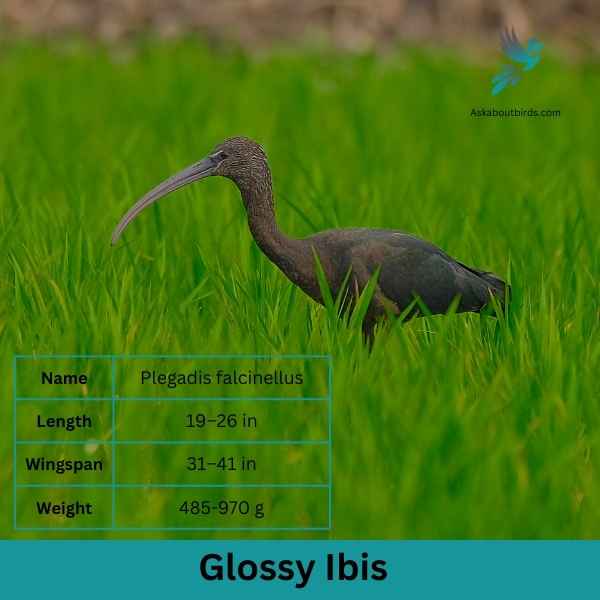

| Feature | Measurement |
|---|---|
| Scientific Name | Plegadis falcinellus |
| Length | 19–26 in |
| Wingspan | 31–41 in |
| Weight | 485-970 g |
The Glossy Ibis (Plegadis falcinellus) is a wading bird that stands out due to its rich, iridescent plumage that appears glossy in the sunlight, showcasing a blend of purples, greens, and browns. This species features a long, down-curved bill and red eyes, which add to its unique charm. Found in a variety of regions worldwide, including parts of the Americas, Europe, Asia, Africa, and Australia, it’s the most widespread ibis species.
The Glossy Ibis favors wetland habitats where it can probe in the soft mud for a diverse diet of insects, small fish, and crustaceans. It nests in colonies, often with other wading birds, building platform nests in trees or reeds. While the global population of Glossy Ibis is large, it faces potential threats such as habitat loss due to drainage of wetlands, pollution, and disturbance. Conservation efforts are focused on habitat protection and restoration, along with monitoring of populations to prevent significant declines.
Similarities
- Like herons, Glossy Ibises are wading birds that feed on a similar diet.
- Both have long legs and a long neck.
Differences
- Glossy Ibises have a distinctive curved bill, unlike herons.
- They have a shiny, dark plumage, unlike most herons.
Green Heron

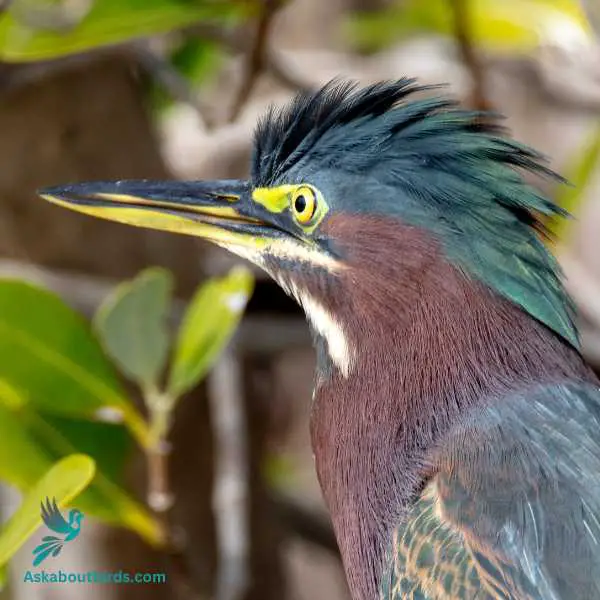
| Feature | Measurement |
|---|---|
| Scientific Name | Butorides virescens |
| Length | 16-18 inches |
| Wingspan | 25-27 inches |
| Weight | 6-7 ounces |
The Green Heron is a small heron found in North America, notable for its deep green back and chestnut body, as well as its unique fishing tactics.
Appearance: Green Herons are dark and compact birds with a glossy, greenish-black cap, a greenish back and wings, and chestnut neck and belly. The bill is long, dark and sharply pointed. Their legs are bright orange or yellow. Young birds are duller in color, with a dark top and streaked brown front.
Diet: The Green Heron’s diet is quite varied, consisting mostly of small fish, but also includes insects, spiders, and sometimes amphibians and small mammals. It’s known for its tool-using behavior where it drops bait onto the water’s surface to attract fish.
Reproduction: Green Herons are solitary birds except during the breeding season, where they form monogamous pairs. Nests are typically built in trees or shrubs near water. Females lay 2 to 5 pale blue-green eggs that both parents incubate.
Similarities
- Green Herons, like other heron species, have a similar body shape with long legs and neck.
- Both feed on a similar diet of fish and invertebrates.
Differences
- Green Herons are smaller and have a more stocky body compared to other larger heron species.
- They have a rich chestnut and green coloration, unlike many other heron species.
Brown Pelican
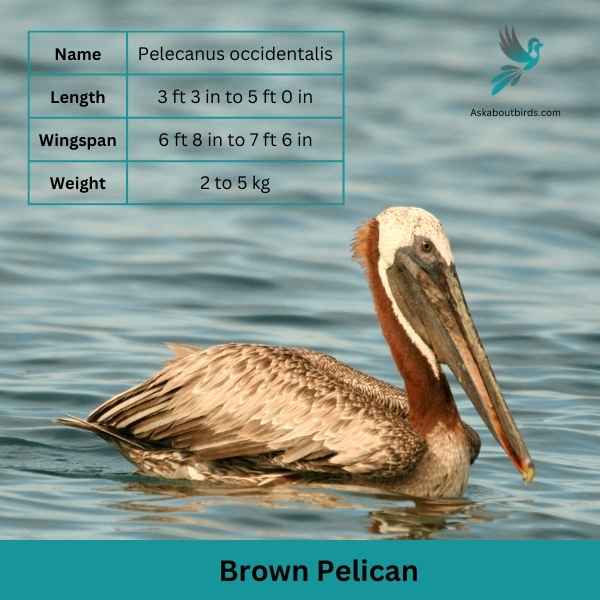
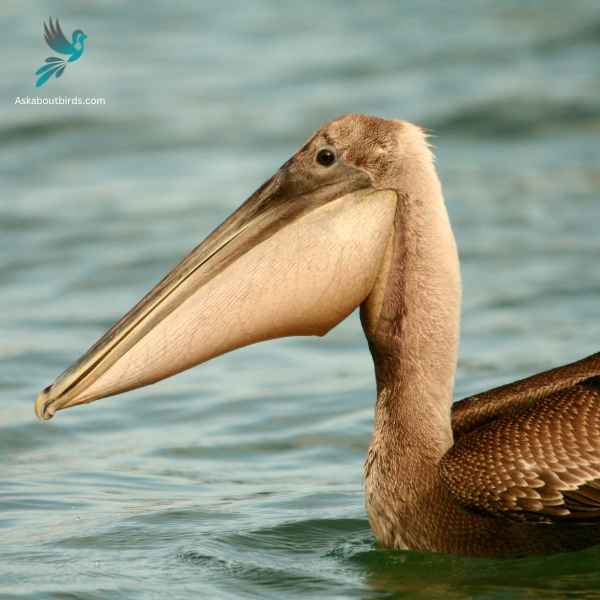
| Feature | Measurement |
|---|---|
| Scientific Name | Pelecanus occidentalis |
| Length | 3 ft 3 in to 5 ft 0 in |
| Wingspan | 6 ft 8 in to 7 ft 6 in |
| Weight | 2 to 5 kg |
The Brown Pelican (Pelecanus occidentalis) is a large water bird recognized by its gray-brown body, white neck, and distinctly large, extendable throat pouch used for capturing fish. Unique among the world’s seven species of pelicans, the Brown Pelican is the only one that dives into the water from the air to catch its prey, making it an iconic sight along the coastal regions of the Americas where it’s often found.
Inhabiting both coasts of North and South America, Brown Pelicans primarily feed on fish, using their large pouches as nets to scoop prey from the water. They’re social birds, often seen flying in flocks, resting communally, or nesting in colonies on islands. Despite having rebounded from the brink of extinction in the 1970s due to pesticide pollution (particularly DDT), Brown Pelicans still face threats including habitat loss, climate change, and human disturbance. Conservation efforts include protecting nesting habitats and monitoring populations to ensure this species remains a staple of its coastal ecosystems.
Similarities
- Both species are large waterbirds with long necks and bills, adapted for a diet mainly composed of fish.
- Both species are often found in similar habitats, particularly near bodies of water.
- Both species have wide wingspans and are strong fliers.
Differences
- Body Shape: Brown Pelicans are stockier with a large body and a distinct pouch underneath their bill for catching fish, while herons have a slender body and a straight, pointed bill.
- Plumage: Brown Pelicans, as their name suggests, have mostly brown and gray plumage, while heron species can range from blue to gray to white, often with added streaks or patches of color.
Roseate Spoonbill

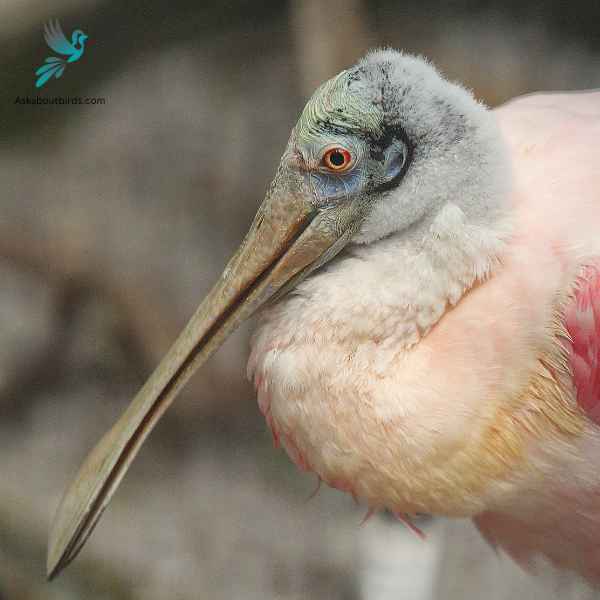
| Feature | Measurement |
|---|---|
| Scientific Name | Platalea ajaja |
| Length | 28–34 in |
| Wingspan | 47–52 in |
| Weight | 1.2–1.8 kg |
The Roseate Spoonbill (Platalea ajaja) is a large, long-legged wading bird known for its unique spoon-shaped bill and striking pink plumage, from which it derives its name.
The species’ eye-catching coloration ranges from light pink to bright magenta, accentuated by a patch of carmine red on the wing and a greenish tinge on the head and neck. The spoon-shaped bill, broad and flat at the end, is a highly specialized tool for feeding, allowing the bird to sweep through the water and scoop up small aquatic animals.
Residing in marshes, lagoons, and mangroves, the Roseate Spoonbill is found in the Americas, from the southern United States through Central America and into South America. They feed on crustaceans and other small aquatic animals, the carotenoid pigments of which contribute to their vibrant pink color.
Similarities
- Both are large wading birds found near water bodies.
- Both species have long legs and necks.
- Both are strong fliers with wide wingspans.
Differences
- Color: Great Blue Herons have blue-gray plumage, while Roseate Spoonbills have bright pink plumage.
- Beak Shape: Great Blue Herons have a sharp, pointed bill, while Roseate Spoonbills have a long, flat, spoon-shaped bill.
Types of Herons
Herons belong to the family Ardeidae, which comprises over 60 species of wading birds. Here are a few examples:
- Great Blue Heron: This is the largest heron in North America, recognized by its gray-blue color, long legs, and sinuous neck and head plumes.
- Little Blue heron: Little Blue Herons are small, slate-blue wading birds known for its gradual color change from white during its first year to blue-gray as an adult, often seen stalking its prey in shallow waters.
- Grey Heron: Found in Europe, Asia, and parts of Africa, it is similar in size to the Great Blue Heron but sports a predominantly grey plumage.
- Green Heron: Smaller and stockier, the Green Heron is noted for its deep green back, rich chestnut body, and dark cap.
- Black-crowned Night-Heron: This heron is recognized by its stocky figure, short legs, black cap, and back with contrasting white underparts.
- Great Egret: Technically a type of heron, the Great Egret is famous for its all-white plumage and black legs and feet.
- Little Egret: This small white heron is recognized by its black bill, black legs, and yellow feet.
- Cattle Egret: It is smaller in size and known for its habit of following cattle around to catch insects stirred up by them.
- Chinese Pond-Heron: Found in East and Southeast Asia, this heron is recognized by its white wings contrasting with the rest of its cinnamon-colored body.
- Goliath Heron: As the world’s largest heron, this species found in sub-Saharan Africa and South Asia is hard to miss.
- Purple Heron: This species is slightly smaller than the Grey Heron and noted for its slender figure and reddish-purple head and neck.
- Tricolored heron: Tricolored herons are sleek and slender birdz found in coastal areas, known for their distinctive three-color plumage of blue-gray, lavender, and white, along with its skillful hunting techniques in shallow water.
- Grey Heron: Grey herons are wading birds known for their striking gray plumage, long neck, and sharp beak, often seen standing still in wait for prey in freshwater or saltwater habitats.
What is the difference between Egrets and Herons?
Egrets and Herons are both long-legged, freshwater and coastal birds that belong to the family Ardeidae. While they share many similarities, there are some key differences:
- Size and Appearance: Generally, herons tend to be larger and bulkier than egrets. In terms of appearance, herons exhibit a wider variety of colors and patterns, whereas egrets are typically white. However, this is not a strict rule as there are some heron species that are white, and a few egret species exhibit color.
- Species: ‘Egret’ is a term used to describe several species within the heron family. All egrets are technically herons, but not all herons are egrets. The term ‘egret’ is usually used for species that have decorative plumes during the breeding season and often have a historical association with the plume trade.
- Feathers: One of the distinguishing features of egrets is the presence of fine plumes, which are specialized feathers that were highly prized for use in fashion in the late 19th and early 20th centuries. These feathers are usually prominent during the breeding season.
- Behavior: While both herons and egrets wade in water to hunt for food, some species of herons are more likely to feed on dry land as well. There are also slight differences in their hunting techniques.
- Bill Color: Many egrets have black bills, while heron bills can be yellow, black, or a combination of colors.
FAQS on Birds That Look Like Herons
What kind of bird looks like a heron?
There are several birds that bear a striking resemblance to herons due to similar body structure, feeding habits, and habitats. These include the egret, crane, stork, ibis, and bittern.
What bird looks like a heron but is bigger?
Cranes often look like larger versions of herons. For example, the Sandhill Crane, with its long neck, long legs, and broad wings, can easily be mistaken for a heron but is generally larger.
What birds look like herons but are smaller?
Egrets, while part of the heron family, are generally smaller than many heron species. Birds like the Green Heron or the Least Bittern are also heron-like in appearance but are smaller in size but have the white head feathers.
What is a large grey stork-like bird?
If you’ve spotted a large grey bird that looks similar to a stork, it might be a Grey Heron. These birds are often confused due to their similar size, color, and wetland habitats. However, you can distinguish them by their necks (herons have an S-shaped curve while storks’ necks are straight), and storks tend to have heavier bills. The Sandhill Crane, which is larger and grey like a heron, is another bird that could fit this description.

